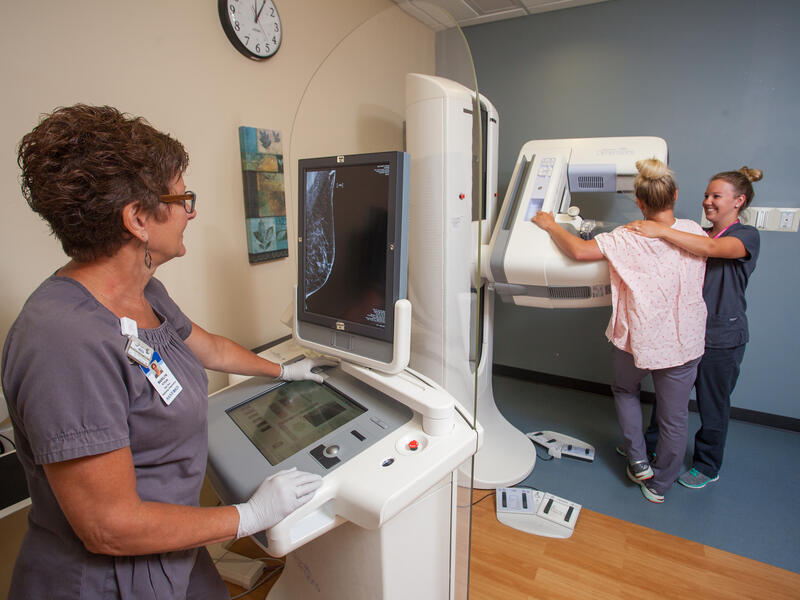Sanford Health recommends women with average risk for breast cancer get a mammogram every year starting at age 40. However, women with a higher risk of breast cancer may need to start getting mammograms earlier and more frequently.
Women with a family history of cancer may also want to start getting screened earlier.
Jamie Williams, M.D., is a fellowship-trained breast radiologist at Edith Sanford Breast Center Sioux Falls who focuses on the early detection of breast cancer. She will explain your mammogram results to you using a standardized rating system that is known as the Breast Imaging Reporting and Data System, or BI-RADS.

This system is not only used for mammograms, but also breast ultrasounds and breast MRIs. This system standardizes breast imaging reports, which allows for consistent, accurate communication and follow-up after the tests much easier.
Mammograms create an image of your breast tissue using a small dose of radiation. Trained radiologists like Dr. Williams then examine the image. Does anything look abnormal? How severe is the abnormality? Radiologists will take this information and sum it up in one number, or score, to communicate their findings to other doctors.
“Screening mammograms save lives,” Dr. Williams said. “That is the most important thing our patients need to know. Screening mammograms are for patients who are not having any issues with their breasts.”
Making sense of the numbers
So how what happens after your annual screening? What do the results of your mammogram really mean?
In a meeting with your radiologist, you will receive your BI-RADS information.
Categories 0-6 for breast imaging mean:
0: Additional imaging is needed. This category is usually only assigned in the setting of a screening mammogram, commonly known as a “callback.”
“If you see that on your exam, it means that something on your screening mammogram caught our eye and we need to further imaging to figure out if it’s something concerning or not,” Dr. Williams said.
1: This means your mammogram is negative, or no signs of cancer were found. You should continue to have routine screenings.
2: This also means your mammogram is normal with no apparent cancer, but that other benign findings were noted. You should continue routine screenings.
3: This means your mammogram is probably normal and the findings are most likely benign. There is a less than 2% chance of cancer. Short-term follow-up imaging is recommended.
4: This means the findings are suspicious and a biopsy is recommended.
5: The findings are highly suggestive for malignancy, and a biopsy is strongly recommended for diagnosis.
6: This means you’ve already been diagnosed with breast cancer and the pathologist has confirmed the diagnosis.
“Categories 3, 4, 5, and 6 are only to be used for diagnostic exams,” Dr. Williams said. “Diagnostic exams are performed either when a patient is call-backed from a screening mammogram, or the patient is symptomatic. During diagnostic mammograms, we perform specialized mammograms with different views that help us discover any abnormalities. Oftentimes we perform diagnostic ultrasound along with a diagnostic mammogram.”
Assessing breast density
Included in every mammogram report is an assessment of breast density. It is an important determination because the denser breasts are, the more difficult it is to detect cancer.
“We know that the sensitivity of a mammogram decreases as breast density increases,” Dr. Williams said. “Cancers can hide in dense breast tissue.”
Breast density is assessed in four categories:
A: Almost entirely fatty
B: Scattered areas of fibroglandular density
C: Heterogeneously dense
D: Extremely dense
“Breast density is also an independent risk factor for developing breast cancer,” Dr. Williams said. “The denser your breasts, the greater the increase in risk of developing breast cancer.”
Those with dense breasts (categories C and D) may want to consider pursuing supplemental screening modalities in addition to annual mammograms.
Taking charge of your health
Knowing and understanding your BI-RADS score and breast density helps you keep track, along with your physician, of what you need to do to actively participate in your medical care.
“The letters sent to patients after they undergo a mammogram are not intended to increase anxiety or be something that patients need to decode,” Dr. Williams said. “They’re there to educate patients and help them tailor their personal individual health care plans to themselves.”
Learn about breast cancer screening options at Sanford Health.
Learn more
- Understanding mammograms and what to expect when you get one
- Mammography vs. thermography for detecting breast cancer
- Annual mammogram catches cancer early for Sanford provider
…
Posted In Cancer, Cancer Screenings, Healthy Living, Imaging, Women's
